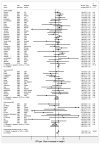Height and prostate cancer risk: a large nested case-control study (ProtecT) and meta-analysis
- PMID: 18768501
- PMCID: PMC2566735
- DOI: 10.1158/1055-9965.EPI-08-0342
Height and prostate cancer risk: a large nested case-control study (ProtecT) and meta-analysis
Abstract
Background: Height, a marker of childhood environmental exposures, is positively associated with prostate cancer risk, perhaps through the insulin-like growth factor system. We investigated the relationship of prostate cancer with height and its components (leg and trunk length) in a nested case-control study and with height in a dose-response meta-analysis.
Methods: We nested a case-control study within a population-based randomized controlled trial evaluating treatments for localized prostate cancer in British men ages 50 to 69 years, including 1,357 cases detected through prostate-specific antigen testing and 7,990 controls (matched on age, general practice, assessment date). Nine bibliographic databases were searched systematically for studies on the height-prostate cancer association that were pooled in a meta-analysis.
Results: Based on the nested case-control, the odds ratio (OR) of prostate-specific antigen-detected prostate cancer per 10 cm increase in height was 1.06 [95% confidence interval (95% CI): 0.97-1.16; p(trend) = 0.2]. There was stronger evidence of an association of height with high-grade prostate cancer (OR: 1.23; 95% CI: 1.06-1.43), mainly due to the leg component, but not with low-grade disease (OR: 0.99; 95% CI: 0.90-1.10). In general, associations with leg or trunk length were similar. A meta-analysis of 58 studies found evidence that height is positively associated with prostate cancer (random-effects OR per 10 cm: 1.06; 95% CI: 1.03-1.09), with a stronger effect for prospective studies of more advanced/aggressive cancers (random-effects OR: 1.12; 95% CI: 1.05-1.19).
Conclusion: These data indicate a limited role for childhood environmental exposures-as indexed by adult height-on prostate cancer incidence, while suggesting a greater role for progression, through mechanisms requiring further investigation.
Figures


References
-
- Tanner JM. Foetus into man: physical growth from conception to maturity. Ware (United Kingdom): Castlemead Publications; 1989.
-
- Gunnell D. Can adult anthropometry be used as a ‘biomarker’ for prenatal and childhood exposures? Int J Epidemiol. 2002;31:390–4. - PubMed
-
- Gunnell D, Okasha M, Smith GD, Oliver SE, Sandhu J, Holly JMP. Height, leg length, and cancer risk: a systematic review. Epidemiol Rev. 2001;23:313–42. - PubMed
-
- Leitch I. Growth and health. Br J Nutr. 1951;5:142–51. - PubMed
-
- Leary S, Smith GD, Ness A. Smoking during pregnancy and components of stature in offspring. Am J Hum Biol. 2006;18:502–12. - PubMed
Publication types
MeSH terms
Substances
Grants and funding
LinkOut - more resources
Full Text Sources
Medical

